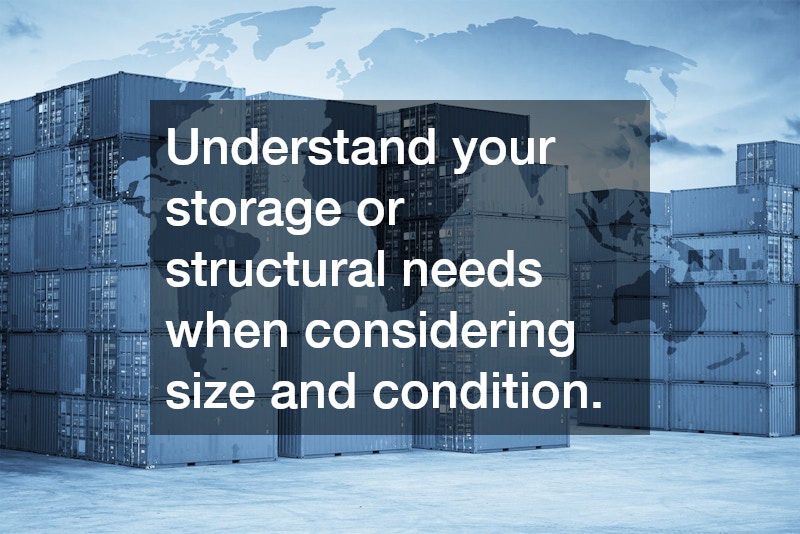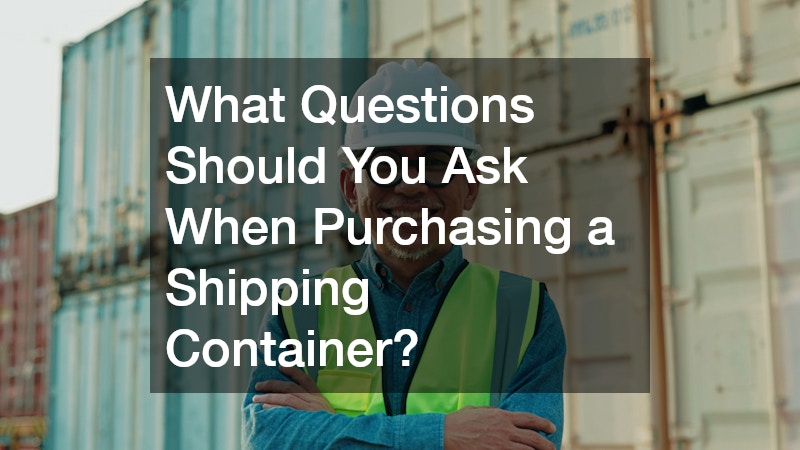Shipping containers have become a versatile asset in various industries, ranging from logistics to innovative architectural projects. Originally designed for transporting goods across the globe, these containers now serve as mobile offices, homes, and storage units. Their robust structure and uniform size make them an ideal choice for numerous applications, but the process of purchasing one requires thorough consideration.
Given their wide range of uses, it is essential to understand what you’re getting into when buying a shipping container. Just like any significant investment, you should ask the right questions to ensure it’s suitable for your specific needs.
Whether you plan to use a container for storage, transport, or as a building material, being informed will help you make the best decision.
Purchasing a shipping container can be a straightforward process if you know what to look for. From checking the condition and size to understanding legal and delivery requirements, each aspect plays a pivotal role in the buying process. This guide aims to arm you with the necessary questions to ask, as well as the information you need to acquire the right container for your needs.
What Size Do You Need?
The first crucial question when purchasing a shipping container is about the size. Shipping containers come primarily in two standard sizes: 20-foot and 40-foot lengths. Selecting the right size depends on what you plan to use it for. For instance, a 20-foot container might suffice for on-site storage needs, but if you’re planning a container home, you might need a 40-foot container or multiple units.
Consider also the height of the container – a standard container has a height of 8.5 feet, while high-cube containers offer an additional foot of vertical space. High-cube containers are excellent for taller items or when converting into habitable spaces requiring more headroom. Understanding your space requirements is vital to deciding the correct size before making a purchase.
Besides the exterior measurements, think about the cubic capacity and how the internal layout affects your needs. Measure your available space to ensure you can comfortably land and place the container, especially if it’s going indoors. Sizing constraints could influence your choice significantly as they affect transportation and final site placement.
What Is the Condition of the Container?
Another pivotal question is regarding the condition of the shipping container. Containers are commonly classified under new, cargo-worthy, wind and watertight, or as-is conditions. New or one-trip containers are typically in the best shape and will serve well for most applications, but come at a higher price point.
Cargo-worthy containers, meanwhile, have served in the shipment industry but are still in good shape to serve storage and conversion purposes. Wind and watertight ones have seen more action, but suffice when budget constraints kick in or for non-critical applications like site storage. It’s crucial to physically inspect the container or request detailed imagery to avoid purchasing a container that requires unforeseen repairs.
Besides the structural integrity, check for any signs of rust, chemical spills, and existing modifications. These factors not only affect the longevity of the unit but also impact the safety and usability for storage or conversion processes. Ensure you are clear on the exact condition to avoid requiring costly repairs or potentially hazardous units.
What Are the Local Regulations?
Before finalizing your purchase, inquire about the local regulations regarding shipping containers. While some areas may not have stringent rules, others require building permits or zoning approvals, especially if the container is intended for construction or residential purposes. It’s best to liaise with your local council or relevant authorities to understand any constraints or requirements.
Failure to comply with local regulations can result in fines or the need to remove the container entirely, leading to wasted time and resources. Additionally, some homeowner’s associations may have specific guidelines on how and where containers can be used on your property. Checking these details ensures your container is legally compliant and avoids any legal complications.
Understanding regulations is not just about avoiding penalties but also ensuring safety. For instance, if your container conversion is intended for living purposes, it must meet certain safety codes and standards. Being informed helps you in planning and constructing in accordance with necessary safety and compliance standards, allowing for a smoother setup and negligence-free usage.
How Will You Transport the Container?
The logistics of transporting a shipping container to your desired location are another critical element to consider. You should ask about the transportation options available from the seller or if you need to arrange your own logistics. The location and accessibility of the final destination often dictate which transportation methods are viable or cost-effective.
Transportation fees vary significantly based on the distance and geographical challenges between the seller’s depot and your site. Some companies offer delivery services that can streamline the process; however, it’s important to compare these costs with third-party alternatives. Considering access points, road conditions, and necessary permits will affect the delivery time and cost.
Moreover, once the container is delivered, you would need suitable equipment, like cranes or forklifts, to offload and place the container on-site. These factors add to the overall cost and should be calculated into your budget planning. Clear communication regarding delivery dates and expectations is essential to ensure smooth coordination and installation of your new container.
Purchasing a shipping container can be a significant investment and should be approached with due diligence. Asking the right questions helps you to make an informed decision and find a suitable container for your needs. The size, condition, regulatory requirements, and logistics are crucial factors that you should consider when choosing a container.
Make sure you understand your storage or structural needs when considering size and condition, and check the compliance requirements of your locality. The logistical aspect of transporting and setting up the container can also impact your decision and should not be overlooked. By considering these key aspects and asking the right questions, you can ensure a successful shipping container purchase.
Whether you are a business owner seeking storage solutions or an aspiring homeowner with plans of container architecture, purchasing the right shipping container requires attention to detail and comprehensive planning. Armed with the right knowledge, you will be better positioned to make wise decisions that meet your specific demands and aspirations.

